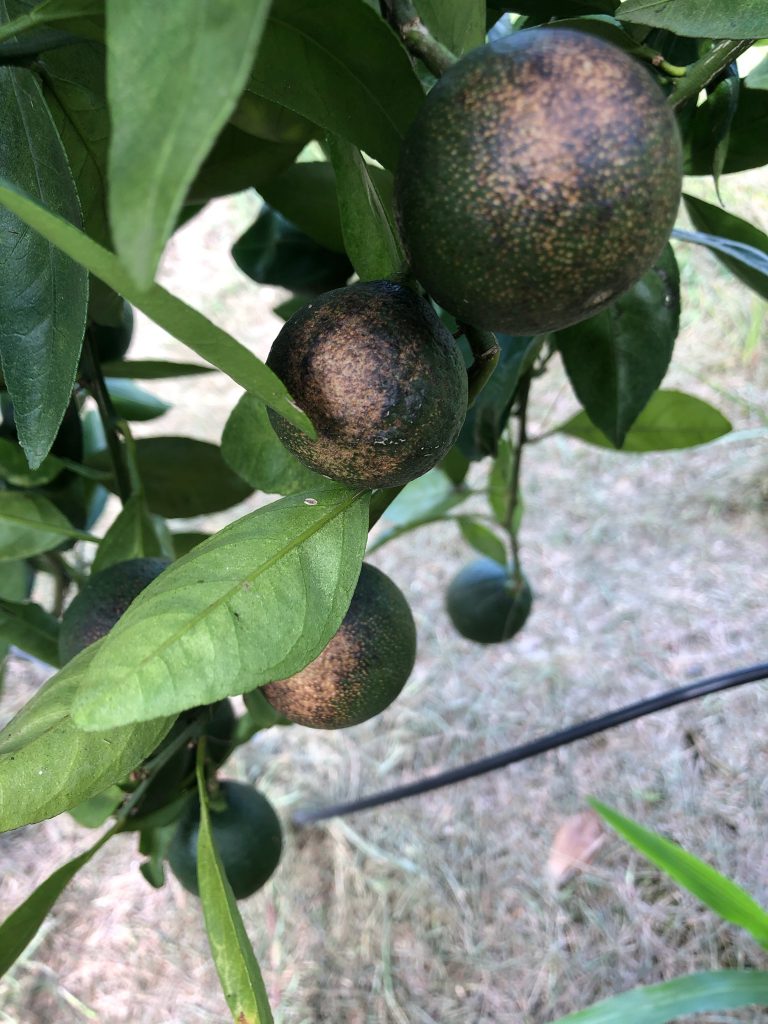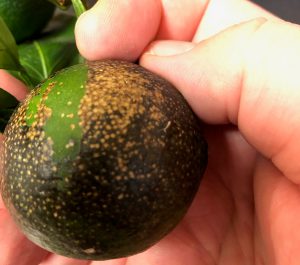In recent years, not a summer has gone by in which I did not see citrus rust mite (CRM) damage in a garden. I thought this year would be the first. Unfortunately, recently I saw my first rust mite damage of the year.
Unlike the myriad of pests that have been recently introduced into Florida from abroad, the citrus rust mite (Phyllocoptruta oleivora) has been documented as present in Florida since the late 1800s. Along with its companion, pink citrus rust mite (Aculops pelekassi) It can be a major summer pest for satsuma mandarins grown in the Florida Panhandle gardens.
Citrus Rust Mite (CRM) damage manifests itself on fruit in two ways, “sharkskin” and “bronzing“. Sharkskin is caused when mites have fed on developing fruit, and destroyed the top epidermal layer. As the fruit grows, the epidermal layer breaks and as the fruit heals, the brown “sharkskin” look develops. Bronzing occurs when rust mites feed on fruit that’s nearer to mature size. Since the skin is not fractured by growth, the fruits develop a polished bronze look. In both cases, the interior of the fruit may remain undamaged. However, extreme damage can cases cause fruit drop and reduced fruit size. Regardless of the condition of the interior, damaged fruit is not aesthetically pleasing, but fine for slicing or juicing.

“Sharkskin Damage” to fruit caused by past feeding by the Citrus Rust Mite. Image Credit, Matthew Orwat
If a CRM population is present, they will begin increasing on fresh spring new growth in late April, and usually reach peak levels in June and July. By August the damage has often already been done, but is first noticed due to the increased growth of the fruit. Depending upon weather conditions, CRM can have a resurgence in October and November, just as Satsuma and other citrus is getting ready to be harvested, so careful monitoring is necessary. For more information, check out this publication: Guide to Citrus Rust Mite Identification.

Sun spot resulting from where citrus rust mite avoids feeding on most sun exposed portion of the fruit. Image and Caption courtesy of EDIs publication HS-806
If control of CRM is warranted, there are several miticides available for use, but it is not advisable for home gardeners to use these on their citrus plants since they will also kill beneficial insects. Horticultural oil is an alternative to miticide, which is less damaging to beneficial insects. Several brands of horticultural oil are formulated to smother CRM, but care must be taken to not apply horticultural oil when daytime temperatures will reach 94 degrees Fahrenheit. Application of oils at times when temperatures are at this level or higher will result in leaf and fruit damage.
Although Citrus Rust Mite (CRM) has the potential to be aesthetically unsightly on citrus fruit in the Florida Panhandle, strategies of monitoring and treatment in homeowner citrus production have been successful in mitigating their damage.
- Woodland Pinkroot Adds Vibrant Color to Spring Landscapes - April 27, 2023
- Easy Care Roses for the Gulf South - April 20, 2023
- Herb Gardening: When Oregano is Flavorless - March 9, 2023

